THE CHANGE OF COMPRESSIVE STRENGTH OF CONCRETE WITH BENTONITE CLAY MINERALS
THE CHANGE OF COMPRESSIVE STRENGTH OF CONCRETE WITH BENTONITE CLAY MINERALS
This study includes a series of experimental studies to investigate the use of bentonite clay minerals obtained from Malatya region instead of some of the cement in concrete production, and thus the effect of the samples produced by reducing the use of cement on the 7- and 28-days compressive strength. For this purpose; %0, %5, %15, %30 bentonite clay was replaced by Portland cement CEM II 42.5 R by volume in proportions and standard mortar samples were prepared in 5 different series, including control samples. Workability of fresh concrete was determined by slump test and flow-table test. Compressive strength tests were performed on 7 and 28 days on the 100x100x100 mm hardened cube concrete samples. As a result of the mechanical tests of the samples, it was determined that the strength increase of the B5 sample at 7 days compared to the control sample was 146% higher.
___
- [1] Grım, R. (1968). Clay Mineralogy. 2nd edition. New York: McGraw-Hill.
- [2] İşçi, S. (2002). Bentonit Dispersiyonlarına Organik ve İnorganik Katkıların Absorbsiyonun Reolojik Özellikleri Üzerine Etkisi. Yüksek Lisans Tezi, İstanbul Teknik Üniversitesi Fen Bilimleri Enstitüsü, İstanbul.
- [3] Chimeddorj, M. (2007). Farklı Bentonitlerin Nem Alıcı (Desikant) Özelliklerinin Belirlenmesi. Yüsek Lisans Tezi, İstanbul Teknik Üniversitesi Fen Bilimleri Enstütüsü, İstanbul.
- [4] Dağ, S. E. (2018). Polimer/Montmorillonit Kompozitlerin Kimyasal Yöntemle Hazırlanması ve Özelliklerinin Belirlenmesi. Doktora Tezi, Ankara Üniversitesi Fen Bilimleri Enstitüsü, Ankara.
- [5] Eruslu, N. (1993). Türkiye bentonitleri ve döküm kumları araştırma projesi. DPT Teknolojik Araştırma Projesi.
- [6] Akbulut, A. (1996). Bentonit. Maden Tetkik ve Arama Genel Müdürlüğü Eğitim Serisi No:32, (s. 1-86). Ankara.
- [7] Çinku, K. (2008). Aktivasyon Yöntemleri İle Bentonitten Su Bazlı Kıvamlaştırıcı Üretiminin Araştırılması. Doktora Tezi, İstanbul Üniversitesi Fen Bilimleri Enstitüsü, İstanbul.
- [8] Kaya, T., & Yazıcıoğlu, S. (2015). Kalsine bentonit katkılı harçların fiziksel ve mekanik özelliklerine yüksek sıcaklık etkisi. BEU Journal of Science, 4(2), 150-160.
- [9] Turkish Standard TS EN 1097-6. (2002). Determination of particle density and water absorption.
- [10] Turkish Standard TS EN 197-1. (2002). Compositions and Conformity Criteria for Common Cements.
- [11] Turkish Standard TS EN 206-1. (2002). Specification, performance, production and conformity.
- [12] Turkish Standard TS EN 12350-2. (2002). Testing fresh concrete - Part 2: Slump Test.
- [13] Turkish Standard TS EN 12350-5. (2010). Testing Fresh Concrete - Part 5: Flow table test.
- [14] Atmaca, N., Atmaca, A., Özçetin, A. İ. (2021). The impacts of restoration and reconstruction of a heritage building on life cycle energy consumption and related carbon dioxide emissions. Energy and Buildings 253, 111507. https://doi.org/10.1016/j.enbuild.2021.111507
- [15] Atmaca, A. (2017). Sustainable life span prediction of shelters constructed in refugee camps in Turkey. Energy, Ecology and Environment 3 (1) 5–12. Springer Science and Business Media LLC. https://doi.org/10.1007/s40974-017-0053-z
- [16] Atmaca, A., Kanoglu, M., Gadalla, M. (2012). Thermodynamic analysis of a pyroprocessing unit of a cement plant: a case study. International Journal of Exergy 11, 2, 152. https://doi.org/10.1504/ijex.2012.049740
- [17] Atmaca, A., Yumrutaş, R. (2015). The effects of grate clinker cooler on specific energy consumption and emissions of a rotary kiln in cement industry. In International Journal of Exergy 18,3,367. https://doi.org/10.1504/ijex.2015.072897
- [18] Atmaca, A., Atmaca, N. (2022). Carbon footprint assessment of residential buildings, a review and a case study in Turkey. Journal of Cleaner Production 340, 130691. Elsevier BV. https://doi.org/10.1016/j.jclepro.2022.130691
- [19] Atmaca, A. (2023). Detailed assessment of specific exergetic costing, energy consumption, and environmental impacts of a rotary kiln in cement industry. Environmental Science and Pollution Research 30, 14, 40260–40282. Springer Science and Business Media LLC. https://doi.org/10.1007/s11356-022-24882-w
- ISSN: 2602-294X
- Yayın Aralığı: Yılda 2 Sayı
- Başlangıç: 2016
- Yayıncı: Gaziantep Üniversitesi
